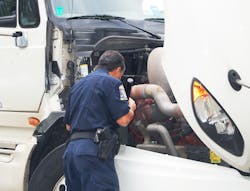In a white paper released late last week, American Trucking Assns. urged the Federal Motor Carrier Safety Administration to remain committed to the goal of its Compliance, Safety, Accountability program: to reduce commercial motor vehicle crashes, injuries and fatalities. But unless FMCSA “acknowledges certain limitations of the program and makes corresponding improvements, CSA will fall short of reaching its full potential,” said Bill Graves, ATA president & CEO.
In the white paper, titled “Compliance, Safety, Accountability – Let’s Not Make it an Ashtray,” Rob Abbott, ATA vice president of safety policy said FMCSA is touting the benefits of its program, even if they don’t match the intended goal.
“According to the first paragraph of the CSA methodology, the goal of CSA is to implement more effective and efficient ways for FMCSA, its state partners, and the trucking industry to reduce commercial motor vehicle crashes, fatalities, and injuries,” Abbott wrote. “Logically, scores in each of the measurement categories should reliably identify carriers more likely to cause crashes. However, in some instances, they do not.”
For example, Abbott pointed out, according to FMCSA’s Evaluation of the CSA Operational Model Test, there appears to be no difference in crash rates for carriers with scores exceeding the intervention threshold in the Driver Fitness BASIC compared to carriers whose scores do not.
The Evaluation report displays this relationship with a graph showing an inverse relationship between scores and crash rates. Despite this finding, FMCSA does not acknowledge that the methodology for this measurement category is flawed and continues to make these flawed scores public, Abbott said. Instead, agency officials point to the merits of identifying carriers with patterns of violations in this category, even though these violations don’t bear a relationship to future crash risk.
“Naturally, we have to ask: Did FMCSA deliberately set out with this in mind when it developed the Driver Fitness BASIC?,” Abbott asked. “It’s doubtful. According to the CSA methodology, each roadside inspection violation is assigned a severity weight that reflects its association with crash occurrence and crash consequences. The sum of these weighted violations is then used to ultimately develop a quantifiable measure of safety for each scored carrier. So by design, the system should identify carriers that have more crash occurrences or, at very least, worse crash outcomes.”
FMCSA runs the risk of going down this same path with its planned Hazardous Materials (HM) BASIC, Abbott said.
“The agency candidly acknowledges that ‘The goal of the HM BASIC is not to predict future crash risk.’ Instead, FMCSA said the BASIC better identifies carriers that are more likely to commit future hazardous materials violations. The agency points to the importance of identifying such carriers since HM can increase the consequences of a crash, but presents no data to show that HM carriers have crashes with worse outcomes as a result of HM violations. Of course, one has to wonder how often some of the most common HM violations (e.g., damaged or deteriorated placards), really lead to more severe crash outcomes,” Abbott said.
FMCSA must guard against revising the goal of the program from identifying those carriers that are the crash-prone, to highlighting the importance of regulatory compliance, he warns.
“It may be tempting for FMCSA to simply change the stated goal of CSA to match the output. Placing an emphasis on compliance is certainly important,” Abbott concluded. “But in the end we should remember that CSA is about prioritizing carriers for intervention. Accordingly, most people would probably agree that the highest priority should be placed on identifying motor carriers and drivers that are causing crashes and changing their behavior.”
